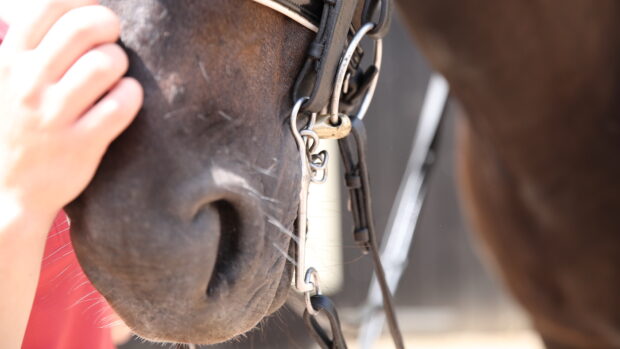The kindest combination bridle available is the Myler Combination (pictured). Based on the Myler bitting principals a mouthpiece with short cheek shanks is selected and connected to the cord and leather noseband.
As the rein contact is taken up, pressure is brought on the nose, back of the jaw and then the poll. This gives a steadying lowering signal, before any contact is made with the mouth and is particularly useful with newly-backed youngsters.
Another popular choice is the combination of the American gag with a German-style hackamore. They are available in many mouthpieces but a jointed snaffle is the most common.
The metal structure of the American gag inflicts a more severe action. The lowering poll pressure is quite strong and the lifting action on the lips and corners of the mouth in standard gags isthought to be the more intense.
When combined with the nose section of the German-style hackamore, the result is an extremely severe bit, even if used with the softer option of two reins.
The Newmarket, Rockwell, and Norton Perfection or Citation, also combine action on the nose section with that of the bit, and are generally seen on trotters.
The mildest of the three, the Newmarket, is a four-ringed, usually mullen-mouthed snaffle, similar to the Wilson. The headpiece and nosepiece attach to the inside rings and the reins to the outer. As the reins come into play, the leather, forming the nosepiece, exerts pressure across the nose.
The Rockwell is similar in action, but the inner rings are replaced with sliding discs attaching to the bit and nose section. The connection at the front forms a strong “Y” similar to the Australian Cheeker, attaching through the browband to the headpiece, bringing pressure across the nose and up the frontof the face.
The Citation is, however, one of the most severe bits of all. It comprises a standard loose-ringed snaffle to which the reins attach. However, also attached to small sliding rings on the mouthpiece (again, like the Wilson) is a second, extremely fine “wire” snaffle, which is further combined with the “Y” nosepiece as in the Rockwell.
When the rein comes into play there is a sharp raising action on the nose, face and corners of the mouth together with a severe double “nutcracker” snaffle action, forming an extremely harsh bridle.
While a bit is only as severe as the hands on the reins, many people would perhaps consider the pleasure derived from riding to be dramatically curtailed if it were necessary to use such a combination on their horse.
|
Read more advice on bitting in Horse & Hound (5 September), or click here to subscribe and enjoy Horse & Hound delivered to your door every week. |
Read more expert bitting advice:



